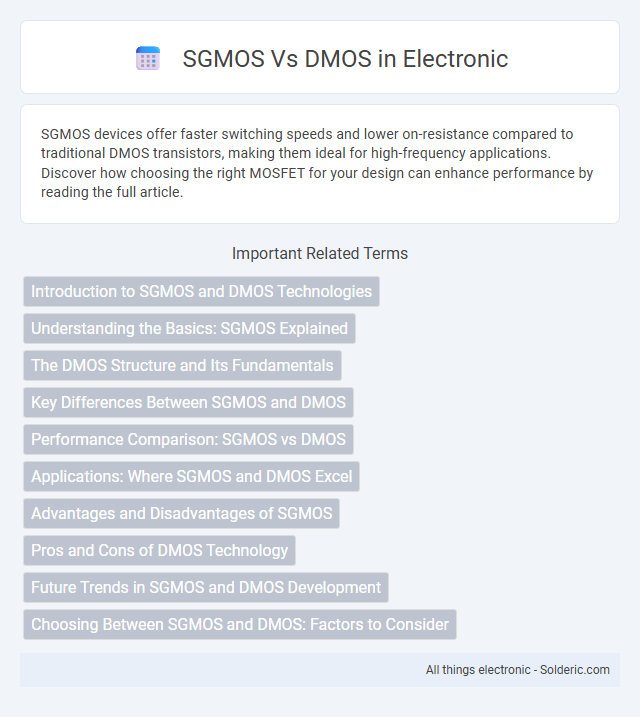SGMOS devices offer faster switching speeds and lower on-resistance compared to traditional DMOS transistors, making them ideal for high-frequency applications. Discover how choosing the right MOSFET for your design can enhance performance by reading the full article.
Comparison Table
| Feature | SGMOS (Super Junction MOSFET) | DMOS (Double-diffused MOSFET) |
|---|---|---|
| Structure | Alternating p- and n-type columns (super junction) | Double-diffused channel with single pn junction |
| On-Resistance (RDS(on)) | Lower due to super junction effect | Higher compared to SGMOS |
| Breakdown Voltage | Higher efficiency for high voltage applications | Good, but limited by single drift region |
| Switching Speed | Faster switching performance | Moderate switching speed |
| Applications | Power supplies, automotive, high-voltage DC-DC converters | General switching, low to medium power applications |
| Cost | Generally higher due to complex fabrication | Lower cost, mature technology |
Introduction to SGMOS and DMOS Technologies
SGMOS (Silicon Gate MOS) and DMOS (Double-diffused MOS) are two prominent transistor technologies used in power electronics for efficient switching and amplification. SGMOS technology features a silicone gate structure that enhances device speed and reduces gate charge, making it suitable for high-frequency applications. Your choice between SGMOS and DMOS depends on specific needs such as voltage handling, on-resistance, and switching efficiency in various electronic systems.
Understanding the Basics: SGMOS Explained
SGMOS (Semiconductor Gate MOS) technology enhances traditional DMOS (Double-diffused MOS) by integrating a more refined gate structure, improving switching speed and reducing on-resistance. The optimized gate oxide thickness and channel doping in SGMOS enable better control over threshold voltage and lower power losses compared to DMOS devices. These advancements make SGMOS well-suited for high-frequency and high-efficiency applications in power management and analog circuits.
The DMOS Structure and Its Fundamentals
The DMOS structure features a double-diffused MOSFET design that optimizes channel length and doping profiles for enhanced current handling and reduced on-resistance. This configuration enables higher power density and improved switching performance, making it ideal for high-voltage and high-current applications. Understanding the fundamentals of DMOS helps you leverage its superior efficiency in power management circuits compared to traditional SGMOS devices.
Key Differences Between SGMOS and DMOS
SGMOS (Static Gate MOSFET) features a single gate structure providing faster switching speeds and lower on-resistance, while DMOS (Double-diffused MOSFET) incorporates a double-diffused channel for enhanced voltage handling and ruggedness. SGMOS is typically optimized for lower voltage applications with better efficiency, whereas DMOS excels in high-voltage, high-power environments due to its robust design. The manufacturing processes differ significantly: SGMOS uses simpler gate formation techniques, whereas DMOS requires a complex double-diffusion step to create the graded channel profile.
Performance Comparison: SGMOS vs DMOS
SGMOS devices demonstrate superior switching speed and lower on-resistance compared to traditional DMOS transistors, making them highly efficient for power applications. Your circuit benefits from reduced conduction losses and improved thermal performance with SGMOS technology, especially in high-frequency operations. DMOS transistors, while robust and cost-effective, often exhibit higher gate charge and slower switching, which can limit performance in fast-switching environments.
Applications: Where SGMOS and DMOS Excel
SGMOS transistors excel in RF power amplification and high-frequency switching applications due to their superior electron mobility and reduced on-resistance. DMOS devices are preferred in high-voltage power management and motor control systems because of their robust structure and ability to handle high drain-source voltages. Understanding your application's voltage and frequency requirements will help determine whether SGMOS or DMOS technology is the optimal choice.
Advantages and Disadvantages of SGMOS
SGMOS (Super Junction MOSFET) offers higher efficiency and lower on-resistance compared to traditional DMOS (Double-diffused MOSFET), making it ideal for high-voltage and power applications. The design of SGMOS reduces switching losses and enhances thermal performance, but it involves more complex manufacturing processes, resulting in higher production costs. Despite these challenges, SGMOS provides superior performance in power density and conduction efficiency, especially in power supplies and motor control systems.
Pros and Cons of DMOS Technology
DMOS technology offers high current handling capabilities and excellent thermal stability, making it suitable for power switching applications and high-voltage environments. However, DMOS devices exhibit slower switching speeds and higher on-resistance compared to SGMOS, which can lead to increased power losses in high-frequency circuits. Despite these drawbacks, DMOS remains favored in applications requiring robust ruggedness and reliable performance under harsh operating conditions.
Future Trends in SGMOS and DMOS Development
SGMOS technology advances with enhanced efficiency and reduced on-resistance, targeting high-frequency and low-power applications, while DMOS continues evolving for high-voltage and rugged power switching needs. Integration of wide-bandgap materials like SiC and GaN propels both SGMOS and DMOS toward improved thermal performance and faster switching speeds. Your choice between SGMOS and DMOS will increasingly depend on specific application demands shaped by these emerging semiconductor innovations.
Choosing Between SGMOS and DMOS: Factors to Consider
When choosing between SGMOS (Superjunction Gate MOSFET) and DMOS (Double-diffused MOSFET), consider factors such as switching speed, on-resistance, and voltage rating to match your application requirements. SGMOS offers lower on-resistance and higher efficiency at high voltages, making it ideal for power conversion and automotive systems. Your selection should depend on whether you prioritize switching performance or ruggedness in high-current environments.
SGMOS vs DMOS Infographic

 solderic.com
solderic.com